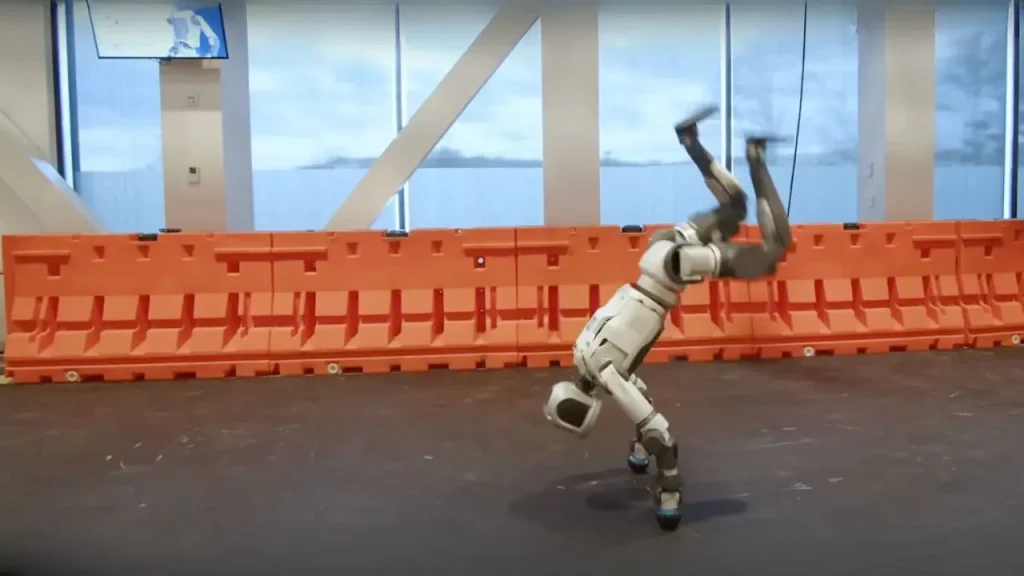In a stunning display of technological advancement, Boston Dynamics has unveiled a new video showcasing its humanoid robot, Atlas, performing incredible breakdancing moves, captivating audiences worldwide. The robot’s seamless execution of complex maneuvers, like the “coffee grinder,” highlights the convergence of cutting-edge robotics, artificial intelligence, and motion capture technology. Developed through a collaboration with the Robotics and AI Institute, Atlas represents a significant leap forward in robotic mobility and dexterity, suggesting a promising future for robotics in various industries.
| Article Subheadings |
|---|
| 1) Atlas showcases impressive breakdancing skills |
| 2) The technology behind Atlas’s dancing abilities |
| 3) Specifications and features of Atlas |
| 4) The cost of advanced robotics |
| 5) Potential applications of robotic agility |
Atlas showcases impressive breakdancing skills
In a mesmerizing demonstration of technology and creativity, Boston Dynamics has revealed the Atlas humanoid robot executing an array of breakdancing moves that would impress even professional dancers. The robot performs complex actions, including the famed “coffee grinder,” forward rolls, cartwheels, and even handstands, showcasing not just its mobility but also its agility and balance.
This latest video has gone viral, attracting significant attention on social media platforms and igniting discussions about the future of robotics and AI. The performance illustrates how far robotics technology has advanced, pushing the boundaries of what robots can do. According to the creators, this rapid progression in robot capabilities reflects years of research and development aimed at creating more nuanced and human-like machines.
The technology behind Atlas’s dancing abilities
The secret to Atlas’s impressive dance routines lies in the integration of advanced artificial intelligence, motion capture technology, and reinforcement learning. Human dancers execute a variety of moves while donning motion capture suits, and these movements are recorded and analyzed. The captured data is then fed into Atlas’s learning model, allowing the robot to learn and refine these movements over time.
Reinforcement learning, a branch of machine learning, enables Atlas to practice these intricate movements regularly until it can replicate them with remarkable accuracy and fluidity. This combination of human artistry and robotic precision creates an awe-inspiring result, demonstrating potential interactions between humans and machines that may redefine performing arts.
Specifications and features of Atlas
Atlas stands at 4 feet 11 inches tall and weighs 196 pounds. The robot can achieve impressive speeds of up to 5.6 mph—approximately 8.2 feet per second—allowing for agile movements. With 28 degrees of freedom, Atlas is capable of performing complex sequences of motion that some might say exceed human capabilities. This advanced unit is outfitted with state-of-the-art lidar and stereo vision systems, enhancing its spatial awareness and environmental interaction.
Unlike earlier models that relied on hydraulic systems, the latest generation of Atlas operates on a fully electric system powered by electric actuators. The robot’s core runs on a custom-designed control and computing platform, empowering it with the intelligence needed for sophisticated tasks and impressive adaptive responses to varying conditions.
The cost of advanced robotics
While Boston Dynamics does not publicly disclose the manufacturing cost of the Atlas robot, industry insiders estimate the production expenses to range between $500,000 and $1 million per unit as of 2025. This substantial investment reflects the cutting-edge materials, technology, and countless hours of research and development dedicated to crafting such a highly advanced robot.
It is essential to note that Atlas functions primarily as a research and development platform, rather than a commercial product available for purchase. Boston Dynamics leases Atlas robots to select partners for strategic research initiatives focused on improving robotics and AI technology, with annual leasing costs anticipated to reach into the six-figure range.
Potential applications of robotic agility
The awe-inspiring performance of Atlas hints at a future where robots could significantly impact various industries beyond entertainment. The remarkable agility and adaptability demonstrated by Atlas have real-world implications, particularly in fields such as emergency response, search and rescue operations, and serving in environments designed exclusively for human interaction, like manufacturing plants. Since late 2024, Atlas has been trialed at Hyundai Motor Group’s vehicle factory, exploring its potential to optimize manufacturing processes.
Robots capable of performing intricate tasks in unpredictable environments could revolutionize industries and enhance safety and efficiency. Consequently, the ongoing development of robots like Atlas could lead to collaborative environments where humans and robots coexist harmoniously, expanding the roles of machines in our lives and workplaces.
| No. | Key Points |
|---|---|
| 1 | Boston Dynamics has showcased Atlas, a humanoid robot, performing complex breakdancing routines. |
| 2 | Atlas’s movements are made possible through advanced AI and motion capture technology that mimic human dance moves. |
| 3 | The robot’s specifications allow for 28 degrees of freedom, advanced sensors, and a fully electric system for enhanced performance. |
| 4 | The estimated production cost of Atlas ranges from $500,000 to $1 million, highlighting its cutting-edge technology. |
| 5 | Beyond entertainment, Atlas’s capabilities could revolutionize industries like manufacturing and emergency response. |
Summary
The unveiling of Atlas’s breakdancing abilities marks a significant milestone in the evolution of robotics. Highlighting the extraordinary advancements in technology, this impressive display serves as both a glimpse into the future of human-robot interaction and a testimony to the potential of robots in various fields. As Atlas blurs the lines between machine and human, the implications for society, industry, and the future of work continue to unfold, opening new avenues for exploration and reflection.
Frequently Asked Questions
Question: What types of movements can Atlas perform?
Atlas can perform various movements, including breakdancing routines, crawling, handstands, cartwheels, and more, showcasing impressive agility and dexterity.
Question: How does Atlas learn its movements?
Atlas learns its movements through a combination of reinforcement learning and motion capture technology, utilizing data from human dancers to improve its performance.
Question: What are the potential real-world applications of Atlas’s capabilities?
Atlas’s agility and adaptability can significantly impact fields like emergency response, search and rescue operations, and automated manufacturing processes.


